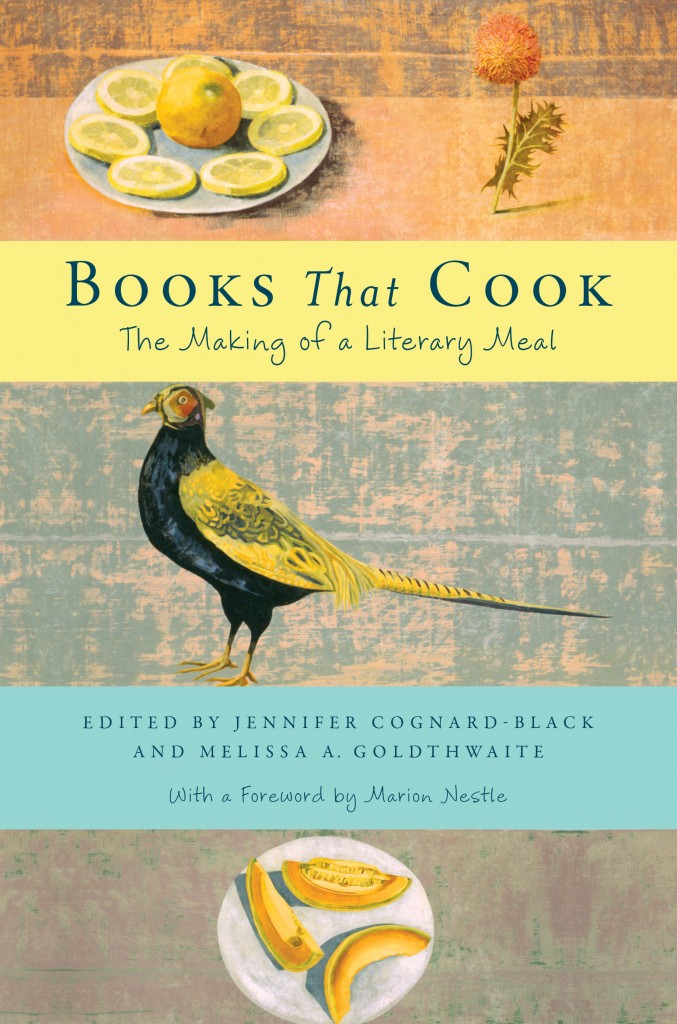 During the month of September, we are celebrating the publication of our first literary cookbook, Books That Cook: The Making of a Literary Meal by rounding up some of our bravest “chefs” at the Press to take on the task of cooking this book! In the next few weeks, we’ll be serving up reviews, odes, and confessions from Press staff members who attempted various recipes à la minute.
During the month of September, we are celebrating the publication of our first literary cookbook, Books That Cook: The Making of a Literary Meal by rounding up some of our bravest “chefs” at the Press to take on the task of cooking this book! In the next few weeks, we’ll be serving up reviews, odes, and confessions from Press staff members who attempted various recipes à la minute.
Next on the menu: Laura Bisberg of NYU Press bakes a cake, Maya Angelou-style.
Read, savor, and let us know what you think in the comments section!
In her autobiographical story prefacing the recipe for Caramel Cake, here’s how Maya Angelou describes the dessert:
The salty sweetness of the caramel frosting along with the richness of the batter made the dessert soften and liquefy on the tongue and slip quietly down the throat almost without notice. Save that it left a memory of heaven itself in the mouth.[1]
So let’s just say my expectations weren’t low. The first step is to make caramel syrup. The instructions sound simple enough:
Heat sugar in heavy skillet over medium-low heat. Stir constantly until melted to a brown liquid. When it bubbles over entire surface, remove from heat. Slowly add boiling water, stirring constantly.
I put the sugar in an enamel pot. (First mistake.) The sound of the sugar scraping across the bottom of the pan is nails on a chalkboard, but cake tastes sweeter for a little suffering. I can bear this.
After ten minutes of stirring, nothing’s changed. I am still just pushing sugar grains around the bottom of a pot. I begin to suspect trickery. I edge the burner up to medium for a few minutes. Then medium-high. (Second mistake.)
It suddenly gets interesting, like a chemistry experiment. The sugar clumps, slowly turns tan. “Yes,” I think. “This seems right.” At twenty minutes, the sugar melts into an amber liquid. Microscopic bubbles appear at the center and foam out from there. “Excellent,” I think. “Just as described.”
I remove the pot from the heat, and stop stirring for approximately 3.2 seconds while I pour out a cup of boiling water from the kettle. (Third mistake.)
Adding the water turns the dainty bubbles into a roiling lava field, the pleasant amber hue to dark rum. Some of the sugar has recrystallized at the bottom of the pot in elaborate configurations. I spoon out a couple of the Chihuly sugar sea monkeys with growing concern that something has gone terribly wrong.
I pour the sugar into a bowl. I dip a spoon in, give the liquid a minute to cool, taste it. How can I describe it? It’s acrid, bitter, tarrish. Like overcooked gym socks. I pour it down the sink.

Take two!
I correct for my mistakes. I use a non-stick pot. I pre-measure the boiling water. I resist the temptation to adjust the heat, and most importantly, I. Do. Not. Stop. Stirring.
It’s a sweltering early September, easily 90 degrees in my kitchen. Twenty minutes in, I badly want the glass of water which is only just out of reach, but I don’t give in to temptation. “STIR CONSTANTLY” is my new mantra. I don’t know exactly what it looks like to make meth, but I imagine it would be a bad time for the cops to raid my apartment as I stand over a pot of white powder at the stove, sweating profusely and refusing to stop stirring.
The sugar eventually goes through a few stages that it completely skipped last batch: snowflakes, sand, sea glass, pulled toffee. It takes close to an hour, but comes out fine this time. It tastes, unsurprisingly, like sugar water.
The rest of the cake comes together easily. I bake it, frost it, take a few photos for posterity.
And the taste? Just like Angelou promised, it’s “a memory of heaven itself,” if heaven tastes like delicious cake. The caramelized sugar and brown butter give it a rich flavor, sweet and salty and intense.
So here’s my advice: make this cake! It’s lovely! And if I scared you off from making the caramel syrup, I have plenty left over. I’d trade it for a kitchen air conditioner.
Laura Bisberg is Business Manager at NYU Press.
[1] “The Assurance of Caramel Cake,” from Hallelujah! The Welcome Table: A Lifetime of Memories with Recipes (Random House, 2007).
